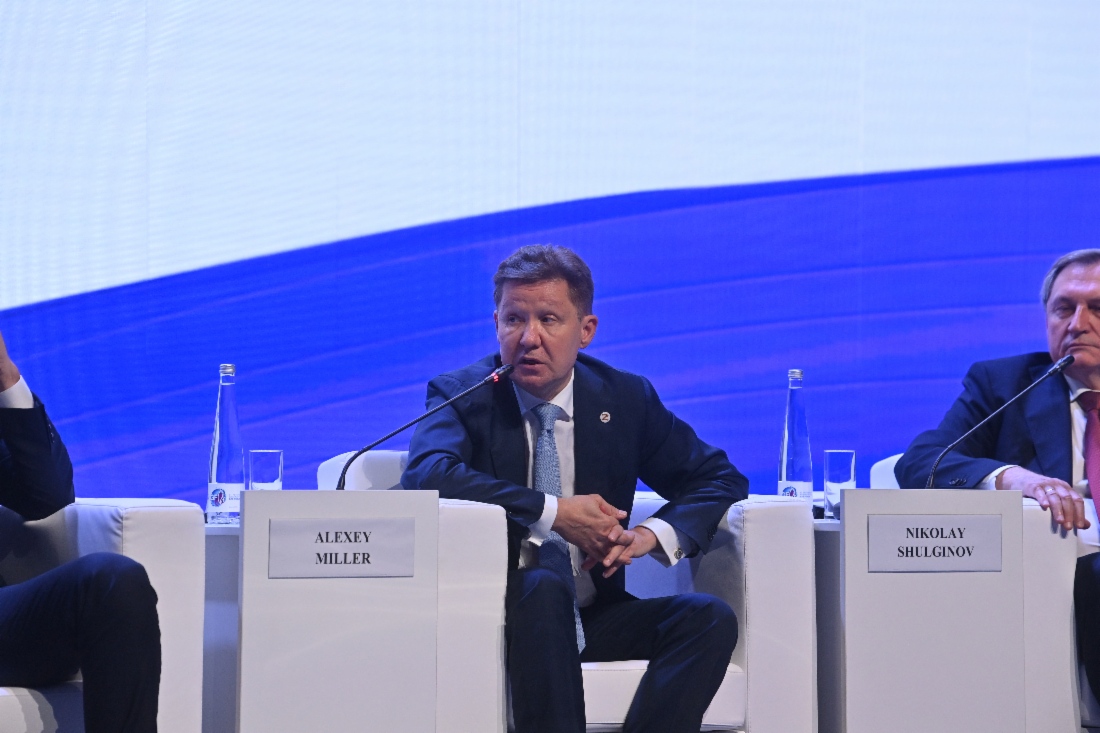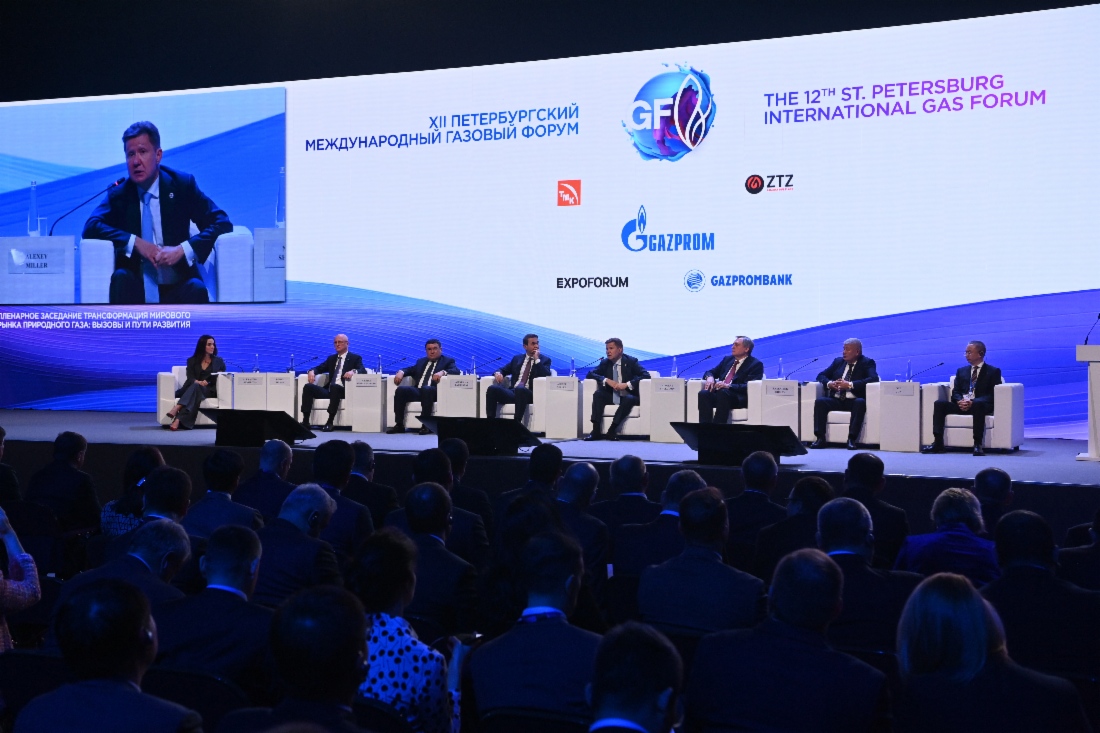Speech by Alexey Miller at “Global Natural Gas Market Transformation: Challenges and Ways of Development” Plenary Session held as part of SPIGF 2023
Shorthand record
Moderator: I am happy to welcome you at the plenary session of the St. Petersburg International Gas Forum! This year, its theme is “Global Natural Gas Market Transformation: Challenges and Ways of Development.”
Could you please tell us how you see the global natural gas market transformation today, what main changes are taking place, and, of course, what has changed in the work of Gazprom?
Alexey Miller: First of all, I would like to greet all participants at this plenary session.
As many as 20,000 people from 35 countries are taking part in the Forum. The number is impressive indeed. The St. Petersburg International Gas Forum has become a very influential expert platform for cooperation in the gas sector.
Just several years ago, the theme of this plenary session could hardly be chosen as the main theme, because, for quite a long time, we worked in one and the same paradigm, but the global gas market is undoubtedly undergoing a transformation. Speaking of this, I guess we can use a synonym for the word “transformation” now, to explain how we understand this process.
We understand it as a “deformation” of the relations that have been developing for decades between traditional consumers and suppliers of gas. And this deformation happened in a very short time. This is point one. And secondly, we, of course, think that the deformation has been caused by unfair competition. The other reasons behind it are incredibly gross errors made by regulators in gas consuming countries and, undoubtedly, the unstable geopolitical situation.
As a result, the global gas market has become excessively volatile, major regional markets have become very volatile. Accordingly, we can say that the global gas market is unstable.
It has to be noted that the gas market will stay “narrow” for Western countries. “Narrow market” is a term used in the gas sector and in the gas market. The market will stay “narrow” for Western countries, while the demand for gas will be steadily growing in the coming decades.
In my speech, I will try to explain why the market will be “narrow” for the West, what factors lie behind the growth in gas demand, and what the ways of development – the topic mentioned in the theme of the plenary session – are.
First and foremost, it has to be noted that the ways of the gas market development will now be definitely determined in the new global centers of economic development, in the countries of the global South and the Asia-Pacific region – the countries with which Russia has been dynamically developing its relations.
In this regard, I would like to mention as an example a very important milestone that took place as recently as on October 7 this year. We have given a new life to the Central Asia – Center gas trunkline system, and, for the first time ever, Russian gas started flowing in reverse to Uzbekistan across Kazakhstan.
The reason why this project was implemented and Russian gas supplies were arranged is, of course, the rapid economic development observed both in Kazakhstan and Uzbekistan. And, as you know, economic growth means growth in energy consumption. The pace is rapid.
Although both Kazakhstan and Uzbekistan are gas producing countries, one should also keep in mind that they have an extreme continental climate. And, just like Russia, they sometimes have extreme cold snaps. These countries know in practice what it means to go through peak loads in the autumn/winter period.
Nevertheless, I would like to emphasize once again that the core reason [behind the project] is the rapid economic development observed in these countries.
I can say it is this project that has now become a signal. A signal for the global gas market that the intensification of the relations in the gas sector between Eurasia's countries is the factor that will to a very great extent define the dynamics of the growth in gas consumption.
If we talk about significant leadership of Eurasia, we have to take as an example the cooperation between Russia and China, which is the cooperation between the largest gas producer and the largest gas consumer in the world.
According to the statistics of China's General Administration of Customs, the share of pipeline supplies of Russian gas have become as large as 33 per cent in a little less than four years. One third. And this year, the pipeline gas supplies of Gazprom accounted for practically a 50 per cent increase in China's imports.
In my speech here at the St. Petersburg International Gas Forum, I would like to thank the organizers of the forum that was just recently held in Beijing and also express my gratitude to the CNPC company, the Vice President of which is taking part in this event today. The forum [in Beijing] was a very high-level event. And the main thing is that the discussions, meetings and negotiations held with regard to the cooperation in the fuel & energy complex and gas sector were indeed exceptionally constructive and substantive. In this regard, I can sum it up that Gazprom will continue to increase its gas supplies to China via the agreed routes.
Of course, the growth of the gas market, the global gas market, will be driven by the development pace of such organizations as the EAEU and SCO, and, naturally, the BRICS group of states. Speaking of BRICS, I think it is reasonable now to compare the BRICS countries with the Group of Seven (G7).
If we make a comparison on the basis of the main indicators that characterize gas consumption, production and reserves, we will see that the ratios are as follows. But first of all, it should be noted that the population of the BRICS countries makes up 46 per cent of the world's total population as of today.
So, what about gas? Let us look at the consumption: the BRICS countries account for 36 per cent and the Group of Seven – for 35 per cent of global gas consumption. As for the production, the BRICS countries account for 35 per cent and the Group of Seven – for 30 per cent of global gas production. As for the gas reserves, the BRICS countries account for 50 per cent and the Group of Seven – for 8 per cent of global gas reserves.
I understand that one might say: “Well, maybe they refer to some other sources.” But let us look at other figures of the year 2022. Countries, as well as organizations, are divided into net importers and net exporters. The Group of Seven and the countries of the European Union represent classic net importers. In 2022, the Group of Seven's net import volume amounted to 144 billion cubic meters of gas. The volume of net gas import in Europe totaled 365 billion cubic meters of gas.
At the same time, we all know well the European gas policy; we know what it is and where it has already led the economy. Firstly, it is a decline in economic and production indicators, especially in such industries as paper, chemicals, metals, and glass. It is the withdrawal of the capital and relocation of the production facilities to other countries, and not to the countries of the European Union, but, in fact, to those across the ocean.
Of course, Gazprom has had many projects that we implemented together with our European partners in Russia. The partners decided to withdraw from our projects. And, you know, nothing happened. Nothing happened, really. We keep working at a steady pace just as we did before. We are fulfilling the plans that we have set for ourselves, even though major licensor companies have left us.
Look at today's exhibition – it is just a joy to the heart and soul. We are already on the verge of complete technological sovereignty. These are not just big words. Complete technological sovereignty is our immediate, very near future.
And if we look at the real-life facts, Western business circles would rather prefer the gas flows from Russia come back. Well, let God be their judge.
Anyway, I just want to draw your attention to the fact that the consumption in Western countries have always been above their past, present or future production. And they cannot reverse this trend. There is no other way. They have no no such reserves. But the role of gas will increase, it will gain importance.
If we talk about forecasts, I will, first of all, talk about the forecasts made by our specialists, our experts and the experts of the Gas Exporting Countries Forum. Over the next 25 years, global gas demand will grow by 43 per cent. At the same time, the share of gas in the global fuel and energy mix will reach 26 per cent. And this means that it is gas that will take the largest share in the global fuel and energy mix. It will happen within the next 25 years.
This is what the new paradigm is aimed at. And I would like to dwell on this paradigm specifically. It goes as: “Natural gas in the electrification of the global end consumer.” What is happening? A new setting is taking shape now, and it is described as “the electrification of the global end consumer,” which is conditioned by the fact that more and more electric power is required, while the growth in the production of and demand for electric power is 1.5 times faster than the growth in the demand for energy resources.
What processes boost the demand for electric power? Digitalization, along with the use of big data banks and artificial intelligence. And most of all, the fact that the share of gas in the power generation sector has consistently stayed at 20 per cent throughout the 21st century and, little by little, this share is gradually and steadily increasing.
Accordingly, the growth in electric power consumption predetermines the growth of the combined cycle and gas-fired power generation, and this is the new setting, which is determined by digitalization and use of big databases and artificial intelligence.
Therefore, dear colleagues, 43 per cent within 25 years – please get ready for this. With Gazprom, everyone can feel absolutely confident, as Gazprom and Russia hold the largest gas reserves. Therefore, we were, are, and will remain a reliable gas supplier for our consumers both within the country and abroad.
Thank you!




